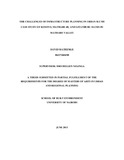| dc.description.abstract | The growth and expansion of slums is alarming and needs more attention. The inability of city authorities to plan effectively as well as enforce urban planning and land laws have given rise to haphazard development of settlements and proliferation of slums. Sustainable development being a major component of urban planning calls on planners to view slums as an aspect of urban development. Therefore the question of slum is not marginal to urban development but it is at its very heart. The purpose of this study is determine the challenges of infrastructure planning in urban slums and takes a case study of three slum settlements, Kosovo, Mathare 4B, and Gitathuru, in Mathare Valley. The study establishes the factors that have led people to settle in the slum settlements and go further to identify the nature and status of the existing infrastructure. Opportunities and challenges for infrastructure provision are established with and an aim of establishing a sustainable infrastructural planning framework that would enhance better living conditions and environmental quality in Mathare Valley.
The study adopted a mixed method approach targeting all the 5,897 households in the study area. The use of several research instruments which included; household questionnaires, interview schedule with key informants, observation schedule that was enhanced by the use of photography and a document analysis guide was employed. Spatial stratified sampling and systematic random sampling approach was adopted to identify the households. In total 85 households participated in this study. The data generated by questionnaires, interview and observation schedules were analyzed using SPSS 17. Spatial data generated by visual image interpretation, field observations and the checklist were supplemented by GPS measurements, and later processed in GIS environment. ARCGIS 9.3.1 was used to carry out spatial analysis and offered an interface between spatial and non spatial data and finally helped in the production of for this study. Analyzed data was then summarized into frequencies and percentages and presented in tables, bar charts and figures.
Findings of the study indicate that urban poverty and the close proximity of the slums to Nairobi Central Business District was the major cause that led people to settle in these slums. In addition to the infrastructural provision in the slums being inadequate the
existing infrastructure was not only inefficient but poorly maintained. Lack of security of tenure, location of slums, and space requirements for infrastructure emerged as the major challenges to infrastructural provision in the slums. In addition to these, existing conflict between the structure owners and tenants aggravated the situation of infrastructural provision. Community participation emerged as the best solution of enhancing infrastructural provision within the slums. The study recommends that measure be put in place to tackle urban poverty by providing economic opportunities for the poor and also recommends that an urban planning framework for slums be incorporated in urban planning. This should take into consideration the existing nature of the slums and provide for measures that are tailored for the slums. Finally, the study suggests that further study be undertaken to determine how issues surrounding struggles between tenants and structure owners in service provision can be alleviated. | en |

